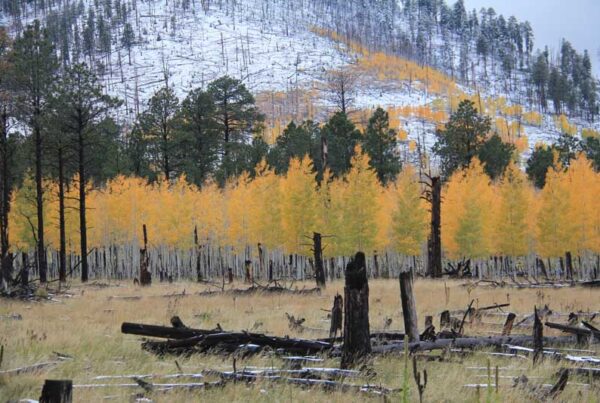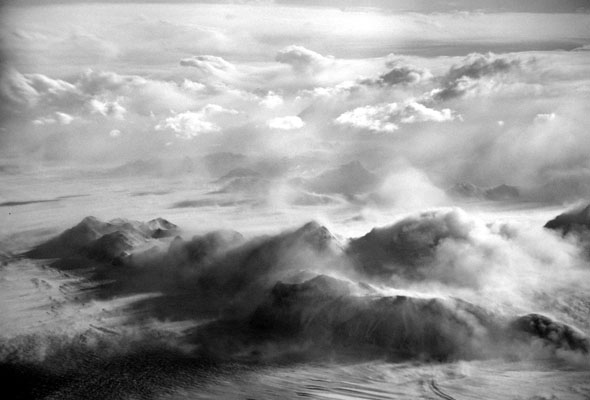Thanks to its extremely low humidity, the Antarctic atmosphere allows the sun to shine with brilliance and clarity, amplified by its reflectance from surfaces of snow and ice. On cloudless days, landscapes resonate with detail as shadows from the passing sun outline every swash of sastrugi and fragment of rock. (Having enough light was never a problem with low speed film.)
Put some haze in the scene, however, and the shadows fade through muted gradations to flat white. It is not good to be traversing under such conditions, when faint signs of crevasses vanish. When a cloud becomes dense enough, it will disperse sunlight uniformly and surface definition will disappear completely, producing the phenomenon known as a whiteout. The flat white of the sky and the flat white of the snow merge into a continuous, blank field, without depth or dimension. The horizon disappears. In this featureless world, one could unknowingly step off a cliff or walk into a wall of snow. If the whiteout is produced by a dense layer of stratus cloud, it is possible to see dark outcrops of mountains many tens of miles away, but become enveloped in cloud and even nearby objects fade completely.
In January of 1979, my party was working in the Churchill Mountains to the south of Byrd Glacier. We pitched camp on snow several hundred yards down from a ridgeline of rock that ran along the crest of the mountains, and gave us access to bedrock for our studies. One day our work was cut short by a cloud that materialized and descended very quickly. I still had some samples to collect and measurements to make, so I sent Scott Borg, one of the party members, scurrying back to the tents, with instructions that if the cloud came down on camp before we were back, to blow a whistle at regular intervals. Sure enough by the time that we reached the low point on the saddle where we needed to turn toward the camp, we were deep in the cloud and suspended in white. Scott was tweeting on the whistle and I was whistling back, so we safely marched the distance to camp suspended in a milky miasma.My most memorable whiteout happened during our take-out from the upper Scott Glacier area in January of 1981. The pilot scheduled to fly the plane was a Lieutenant Commander named John Paulus, who was completing his third three-year tour of duty flying and landing ski-fitted Hercules C-130’s all over Antarctica. Nicknamed “Cadillac Jack,” Paulus was the “old man” of the squadron and, among the ranks of VXE-6, was legendary for the places he had landed. For example, he had done the original put-in at our site 11 years earlier, transporting a New Zealand party that were to traverse the length of Scott Glacier with snowmobiles. The Kiwis had hoped to be put down near Mt. Howe, the southern-most outcrop of rock on the planet, but vast crevasse fields in the headreaches of Scott Glacier prevented landing farther south than the La Gorce Mountains.
The day of our pick-up the weather was fine. The Herc flew into view. We packed the radio and the last standing tent. The big plane took a long, low pass over the landing site, then lifted into the air and flew away straight into the morning sun. I thought that Paulus must be messing with us, but when the plane kept on its heading to McMurdo, we unpacked the radio and called to see what was up. “Faulty hydraulics” were what was up. One of the skis wouldn’t lower properly. Okay, no problem, see you tomorrow.
The following day was again fine, but when we radioed in we heard that we were not on the day’s sched because Paulus wanted our pull out, and he needed a day of rest according to rules. So again, no problem. See you tomorrow. Except that we were running low on food. Furthermore, that night while we slept, a storm came down straight off the plateau, and not just blowing snow, but lots of precip as well. By the time it played itself out 12 hours later, we were deeply drifted in, and a dense cloud had settled into a ceiling at about 7,000 feet. We could see the lower flanks of peaks some forty miles down Scott Glacier, but where snow met sky the whiteout was complete. “Visibility 50 miles, surface definition nil” was our hourly weather report to McMurdo.
By the following day the cloud was thinning enough to begin to perceive a horizon, but it still hung in there as a stable ceiling. Paulus was flying a cargo run to the South Pole that day, but he intended to refuel enough to allow him a dog-leg to our pick-up site. We were in hourly contact with the Herc as it flew to the Pole and then launched in our direction. The ceiling was showing signs of thinning, but it held persistently as the plane neared. From above the clouds, the view would have been a flat sea of cottony white with mountains piercing through. Flying down into a stratus cloud without being able to see what is beneath simply isn’t done. However, flying in under such a cloud from an opening might be worth a shot if your balls are big enough.
Miraculously, with the Herc about ten minutes out, a hole opened in the ceiling and I saw a patch of blue about 10 miles to the northeast. Paulus was keying the radio as he spotted the hole, circled back, and dropped into it on a header to camp. As he approached, our red parkas were the only points of reference in a sea of white that engulfed his view. The Herc slowly descended, the glacier gently rose, we were standing at the intersection. With a roar, the plane hit the ground precisely abreast of us, and not more than two wing-spans away.
The screaming machine turned, lumbered back to camp, and stopped. The giant cargo door dropped at the rear of the Herc and the first man off was Cadillac Jack. With neither hat nor gloves, he strode over to us, took off his sunglasses, and shook the hands of everyone in the party. As I looked into his eyes, I saw an iciness that mirrored the landscape he had mastered through all those years. This mission was truly a fitting, final hurrah. Paulus retired to Montana after that season, but a pleasing postscript to the story is that the following year the powers-that-be named the runway at the Amundsen-Scott South Pole Station, Jack F. Paulus Skiway, in honor of Cadillac Jack.Gallery – Starshot Drifts
During the 1978-79 field season, I worked from a camp in the Starshot Glacier area that displayed a particularly beautiful set of drifts.








